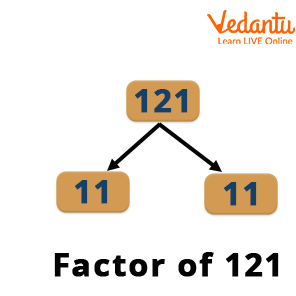




Factorisation of 121: An Introduction
As we all know that
Definition of a Factor of an Integer
A factor of an integer is another integer that can divide the integer without leaving any remainder i.e., an integer
A factor can be both a positive and a negative integer that we will understand by the same example above. As
Proper and Improper Factors
As
Prime Factors
As the name suggests, a prime factor of an integer
Pair Factors
A pair of integers
What are the Factors of 121
Factors of
Hence, by definition,
If we consider negative factors also, then
Method of Finding the Factors of 121
In this section, we will learn how to find the factors of
In Step 11, the quotient and the divisor are the same i.e.,
Hence, the factors of
Moreover, notice that in Step-11,
Here, also, we can use the divisibility rule of integers to check whether
Prime Factorisation of 121: Factor Tree
A prime number is a positive integer
One of the most useful methods of finding the factors of an integer is prime factorization. In this method, we factorize an integer only into its prime factors. Let us find the prime factorization of
In the first step, we take the smallest prime number
Next, we proceed to the next prime number i.e.,
Proceeding similarly, we get the first prime number that divides
In the next step, we take the quotient
As we have got
In brief, we perform the following in the above four steps:
Therefore,

Factor Tree of 121
Now, we can find all the factors of
First, write all the prime factors as many times as they occurred:
Now, multiply them and get:
Also,
Now, list all the factors. Hence, all the factors of
Factors of 121 in Pair
A pair factors of
We have,
Hence, by definition, the pair factors of
Interesting Facts
The sum of all the factors of
Did you know that there are no factors of
The smallest factor of any number is
Prime numbers have exactly two factors:
Composite numbers have more than two factors.
Solved Examples
Example 1: Find the sum of all the factors of 121.
Solution: To find the sum of all factors of
Example 2: Find the sum of all the prime factors of 121.
Solution: We know that 11 is the only prime factor of 121
And therefore, the sum of the prime factors is 11.
Conclusion
In this article, we learned the factors of
Practice Questions
Find the smallest and the largest factor of
Find H.C.F. of
Is
Answer
No.
FAQs on Factors of 121
1. Is the number
2. Is 121 a perfect square? If yes, find its square root.
By prime factorization of
3. What characterizes 121 as a palindrome?
Palindromes are numbers that remain the same when their digits are switched around. A number is a palindrome, in other words, the digits appear the same when read from right to left or left to right. Palindromic numbers include, for instance, 121, 99, 2332, etc. Because it appears the same both forward and backward, the number 121 is a palindrome.











